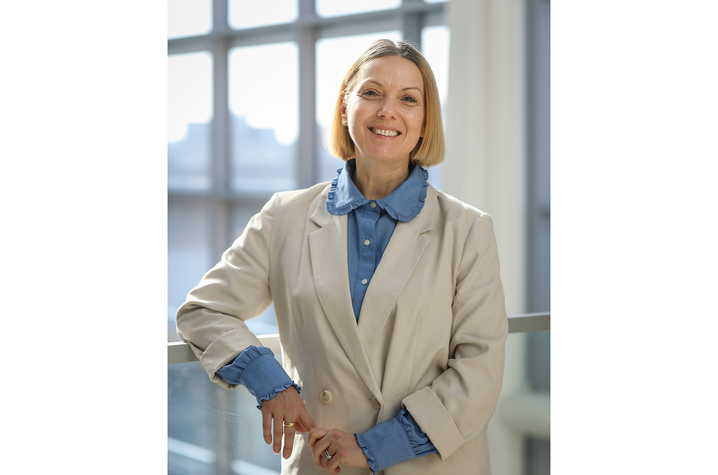$3.1 million NIA grant to advance Sanders-Brown researcher’s groundbreaking dementia study
LEXINGTON, Ky. (April 4, 2024) — Maj-Linda Selenica, Ph.D., assistant professor in the University of Kentucky College of Medicine and associate director of outreach and partnerships at UK’s Sanders-Brown Center on Aging has been working on research surrounding misfolding of the protein TDP-43 for several years now. Thanks to a recent $3.1 million grant from the National Institute on Aging (NIA), the groundbreaking work will continue.
“We have uncovered completely novel modification of TDP-43 that uniquely and irreversibly changes the cellular mechanisms in the brain,” said Selenica.
TDP-43 proteinopathies — diseases caused by misfolded proteins — pose enormous risk to public health, but scientists have few strategies to intervene. Selenica and her lab have discovered that peptidyl arginine deiminases (PADs) promote the conversion of one amino acid, arginine, to another, citrulline, within the TDP-43 protein, a process called citrullination. This process modifies TDP-43 and may be a potential therapeutic target.
This work, focused on brain proteins, began in 2017 during Selenica’s time at the University of South Florida (USF) College of Pharmacy. “It all started as any good simple experiment does, we wanted to see whether citrullination affected TDP-43 protein,” said Selenica. “Moving forward we then wanted to study this very carefully and detailed because the role of citrullination of TDP-43 was completely unknown.”
Early on in Selenica’s work with TDP-43, her team made novel antibodies for the citrullinated TDP-43, as they did not exist as research tools. The team was able to use these antibodies to start looking at the potential mechanisms.
“Alzheimer’s disease (AD) brains and dementia brains undergo longstanding stress, so we asked the same thing of the cellular models and cross validated our findings in animal models,” said Selenica. “We obviously cannot mimic what happens in the human brain, but these models permit us to understand mechanisms that underlie the human disease.”
Selenica’s lab collaborated with Sanders-Brown’s Daniel Lee, Ph.D., associate professor in the UK College of Medicine, and co-investigator on the grant. He was first to investigate the effects of PAD-dependent tau citrullination in AD. Their combined efforts now focus on better understanding how citrullination impacts TDP-43, tau and other pathological proteins that affects brain function and Alzheimer’s Disease Related Dementias (ADRDs).
Indeed, years ago, using the terms “Alzheimer’s disease” and “dementia” interchangeably was accepted. Now scientists understand that a variety of diseases and disease processes contribute to dementia, which is why so much of the ongoing work within the labs at Sanders-Brown are connected in some way. Selenica and Lee’s laboratories are joining forces to focus on two prominent pathological hallmarks in ADRD.
A few years after her work began at USF regarding TDP-43 pathology, Selenica’s now-colleague Pete Nelson, M.D., Ph.D., professor of pathology and laboratory medicine at the UK College of Medicine, and neuropathology core leader at Sanders-Brown, led a group of international experts who characterized TDP-43 as a new form of dementia. Emerging research indicates that TDP-43 contributes to dementia syndromes and in 2019 the disease was officially characterized and named limbic predominant age-related TDP-43 encephalopathy (LATE). Selenica then collaborated with Nelson to look at human brain tissues with LATE and AD+ LATE from the UK Alzheimer’s Disease Center Tissue Bank housed within Sanders-Brown. Nelson is also a co-investigator in this new grant.
“This is one of the big advantages of Sanders-Brown. Our collaboration within the center is unmatched,” said Selenica.
Through Selenica’s research, her lab identified elevated PAD2 and PAD4 expression and TDP-43 citrullination at the beginning of LATE and in ADRDs. Protein citrullination is a well-known biomarker of inflammation. When examining brain tissue from Alzheimer’s disease (AD) patients, scientists have found elevated protein citrullination in the same locations as amyloid plaques.
Based on her prior research and the work that is planned thanks to the new NIA grant, Selenica is hopeful it can result in several therapeutic avenues to target TDP-43 (via citrullination) early in the disease development process. “I’m hoping that several years from now we can develop disease-modifying therapeutic strategies and future biomarker assays targeting TDP-43 pathology,” said Selenica. And she doesn’t think the work will stop there. “I think this project will open the field to much more fruitful collaborations. It has us really thinking about, could we develop something to target all the pathologies at once?”
Selenica and her lab are now preparing a paper describing their results and plan to submit it for publication in the coming months.
Research reported in this publication was supported by the National Institute on Aging of the National Institutes of Health under Award Number RO1AG084670. The content is solely the responsibility of the authors and does not necessarily represent the official views of the National Institutes of Health.
As the state’s flagship, land-grant institution, the University of Kentucky exists to advance the Commonwealth. We do that by preparing the next generation of leaders — placing students at the heart of everything we do — and transforming the lives of Kentuckians through education, research and creative work, service and health care. We pride ourselves on being a catalyst for breakthroughs and a force for healing, a place where ingenuity unfolds. It's all made possible by our people — visionaries, disruptors and pioneers — who make up 200 academic programs, a $476.5 million research and development enterprise and a world-class medical center, all on one campus.





